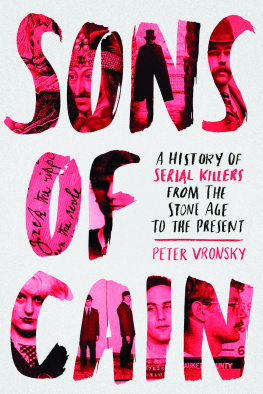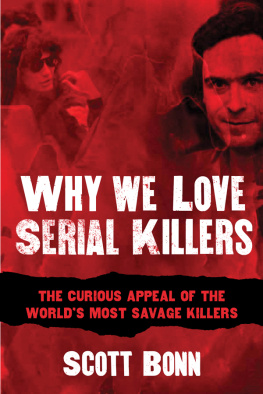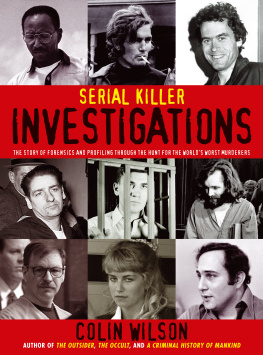Copyright
English Translation Copyright Dundurn Press, 2015
Published originally under the title: Mes tueurs en srie 2011, ditions de lHomme, division of Groupe Sogides inc. (Montral, Qubec. Canada)
All rights reserved. No part of this publication may be reproduced, stored in a retrieval system, or transmitted in any form or by any means, electronic, mechanical, photocopying, recording, or otherwise (except for brief passages for purposes of review) without the prior permission of Dundurn Press. Permission to photocopy should be requested from Access Copyright.
Project Editor: Michael Melgaard
Copy Editor: Jess Shulman
Design: Colleen Wormald
Cover Design: Courtney Horner
Cover Image: Evgeny Dubinchuk
Epub Design: Carmen Giraudy
Library and Archives Canada Cataloguing in Publication
Fezzani, Nadia, 1976- [Mes tueurs en srie. English] Through the eyes of serial killers : interviews with seven murderers / Nadia Fezzani.
Translation of: Mes tueurs en srie. Includes bibliographical references. Issued in print and electronic formats. ISBN 978-1-4597-2467-9 (pbk.).--ISBN 978-1-4597-2468-6 (pdf).-- ISBN 978-1-4597-2469-3 (epub)
1. Serial murderers--United States--Interviews. 2. Serial murderers-- Psychology. 3. Criminal psychology. 4. Criminal behavior, Prediction of. I. Title. II. Title: Mes tueurs en srie. English.
HV6529.F4913 2015 364.15232092273 C2014-906760-7 C2014-906761-5
We acknowledge the support of the Canada Council for the Arts and the Ontario Arts Council for our publishing program. We also acknowledge the financial support of the Government of Canada through the Canada Book Fund and Livres Canada Books, and the Government of Ontario through the Ontario Book Publishing Tax Credit and the Ontario Media Development Corporation.
Care has been taken to trace the ownership of copyright material used in this book. The author and the publisher welcome any information enabling them to rectify any references or credits in subsequent editions.
J. Kirk Howard, President
The publisher is not responsible for websites or their content unless they are owned by the publisher.
Visit us at: Dundurn.com
@dundurnpress
Facebook.com/dundurnpress
Pinterest.com/dundurnpress
Foreword
While many people commit relatively minor violations of the law, most of us do not spend our waking hours plotting crimes that harm others. And yet, on a daily basis, we may come into contact with criminals, even very violent ones. Hidden in the darker recesses of our social fabric are those who live double lives: rapists, child molesters, pedophiles, stalkers, and serial killers. They seem impossible to understand because they rationalize their actions and pretend they are normal. Many fit into our social landscapes like chameleons. They develop skills that enhance their ability to prey upon children, women, seniors, teenagers, prostitutes, homosexuals, and others who fail to see the pending dangers. Many of these predators use violence as a way to express their own suffering, anger, and hate. They are the dark side of humanity.
Serial killers stand out not only because they murder the innocent, but also because of the manner in which they kill. Some serial killers take great satisfaction, even sexual gratification, in making their victims suffer. Others prefer to kill their victims quickly to have their bodies for later mutilation and sexual pleasure. Yet other serial killers seek out victims in order to profit financially. Serial killers vary in their methods of murder, motivations, social class, gender, and race. However, they all share a common characteristic: all serial killers seek control and power over their victims. About 2 percent of serial killers are psychotic, meaning that they suffer from hallucinations, hear voices, and experience significant cognitive impairments, but the vast majority of serial killers are psychopaths. Having worked in a state psychiatric institution for the criminally insane, I came to appreciate the important distinctions between psychotics and psychopaths. Not knowing these distinctions can get you seriously hurt or even killed.
Psychopaths are people who become devoid of emotions such as guilt, remorse, sorrow, compassion, and empathy. No one wakes up one morning and decides to become a psychopath or a serial killer. These are processes that begin in childhood and develop through puberty and into adulthood. We cannot discount the influence of biological predisposition to violent behaviour: genetics can influence some people toward violence. However, predisposition does not determine behaviour. Social environment, poor parenting, childhood trauma, and lack of nurturing play a major role in the development of psychopathy. Psychopaths lack the capacity to form healthy emotional attachments and are fuelled by anger and hate. They are often very good at manipulation, lying, and using others to gratify their personal wants and needs. Unlike most healthy people, who have no desire to control others, psychopaths have a distinct need to control people. Indeed, many psychopaths are not criminals but just enjoy the control. Criminal psychopaths are the most dangerous people in our communities because they use criminal means to control their victims.
Like psychopaths, sex offenders also must be viewed on a spectrum of development. Some engage in relatively minor inappropriate sexual behaviours, while others develop into sexual predators. Russell Williams, the former Canadian wing commander, progressed from voyeurism to stealing womens undergarments and wearing them to serial rapes and, ultimately, to serial murders. Sound complex? Such a dark side is indeed challenging to sort out. Do some people actually possess criminal personalities? Criminality is like peeling the many layers from an onion. There are many layers of criminal thinking, psychopathy, and, for some, sexual deviance. The dark side resides at the deepest layer. People with those capacities live among us, and when they feel so inclined we can become their prey.
As an academic researcher and crime consultant in the criminal justice system, I have interviewed many psychopaths, rapists, child molesters, arsonists, and paraphiliacs, as well as several serial killers. I understand how they think and behave, and what drives them. I strive to provide insight and unique perspectives into the world of violent predators. However, there is one personal perspective I cannot give because I have never been victimized. I can talk about the phenomenon and provide insight into victim-offender relationships, victim profiles, victim services, victim advocacy, and many other important areas of victimology. But I cannot tell you how it actually feels to have been violated, to have my freedom diminished, to fear for my safety. This is what victims share when they feel safe enough to tell.
The author of this book, Nadia Fezzani, is a victim who has spoken out. She is an intelligent, caring, warm person, and also an investigative reporter with a passion for understanding human behaviour, especially the behaviour of those who want to harm others. The victimization she experienced in childhood became the catalyst for looking into the minds and souls of serial killers. It has taken her on a journey she never anticipated, which has culminated in this insightful book. It takes bravery and aplomb to sit across from men who have repeatedly raped and killed, even if these men are imprisoned. Do not think for a moment that such interviews come easily. Nadia Fezzani devoted much time and effort preparing to see these killers. She was willing to cross the chasm, not as a groupie or a social voyeur, but as someone who needed to understand and ask deep questions about the lives and crimes of serial killers.












